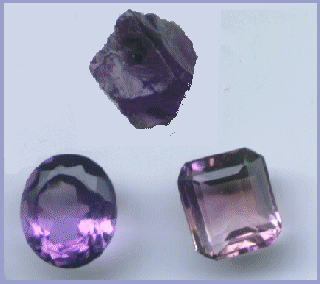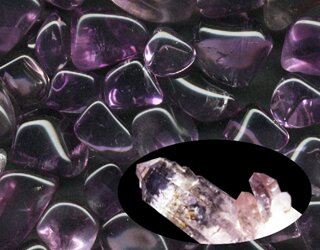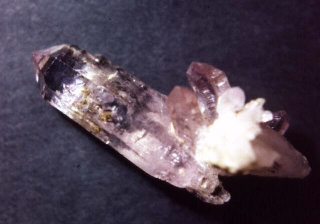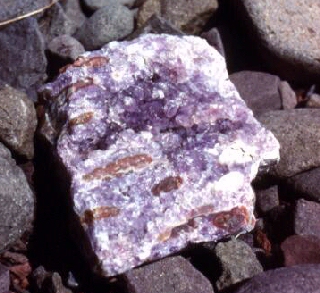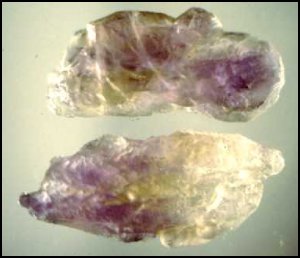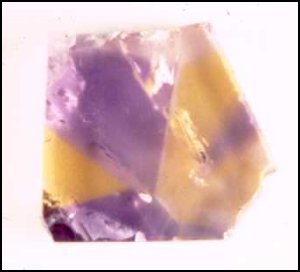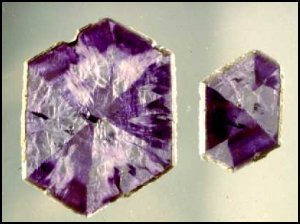Amethyst usually is a transparent variety of quartz that comes in shades of purple. Some translucent to opaque amethyst is also found and the purplish zones alternate with white or grayish areas. Color zonation can be very intense in transparent, translucent and opaque varieties. Amethyst is the traditional birth stone for the month of February.
Quartz in all varieties is Silicon Dioxide, SiO2, it crystallizes in the hexagonal system, it has a specific gravity of 2.66, and it defines 7 on Mohs hardness scale. it has refractive indexes ranging from 1.544 to 1.553, it is uniaxial, positive, and may be strongly dichroic in several colored varieties.
Most of the amethyst that is used in the gem trade now comes from Brazil. Historically, the Ural Mountains in Russia produced many fine amethysts and thousands were acquired by Catherine the Great. The most desired hues ranged from deep purplish-red to purple-red and these stones were called Uralian or Siberian Amethyst, terms that are now color grades rather than source areas.
Amethysts from Brazil are mostly extracted from large geodes that are found in basalts of either Triassic or Jurassic age that crop out in the State of Rio Grande do Sul, in the southeastern corner of the country. Many of these geodes were commonly seen for sale in gem shows in the late 1980's and early 1990's, but fewer of them have been seen in the late 1990's. Many of the geodes with transparent amethyst were broken down to small crystals for the gem trade and this kind of geode is now fairly scarce intact.
Some very attractive amethyst has been produced in Mexico but most of it that has been of desirable gem shades formed in crystals that were quite small and many of the larger crystals were not sufficiently toned to produce fine faceted gems. The amethyst from Mexico has produced many fine, large cabinet specimens that appear in both private and museum collections. When I first took up lapidary in 1961, there were some amethyst tips from Mexico that were nicely colored and produced fine cabochons but they were all nearly opaque. Some of the Mexico specimens had nice small phantom crystals of amethyst in a colorless body of rock crystal.
In North America a great deal of amethyst is extracted from mines in the Thunder Bay, Ontario, Canada, area. There are several commercial mines and several fee localities where one can pay to collect. The status of the mines and fee localities varies from year to year so it is best for one to write or call ahead before planning trips to these areas. Most of the amethyst from Thunder Bay is strongly color zoned and these zonations appear as chevrons if the cut is diagonal to the c-axis of the crystal or sometimes as six triangles of alternating purple and colorless or white areas if the cut is made perpendicular to the c-axis of the crystal. The latter have been called Port Arthur Amethyst. Port Arthur was the name of a port in the Kwantung Province of Manchuria; this area was an historic producer of very fine amethyst. Port Arthur was also the former name of Thunder Bay, Ontario. Which of the Port Arthurs yielded its name to that color zonation of amethyst is currently unknown to me. Some very fine examples of color zoned amethyst similar to the Port Arthur Amethyst appeared in gem shows in the early 1980's; this material was from India.
The strong color zonations of the Port Arthur Amethyst is probably produced by numerous twinned crystals and twinning planes within the crystal. When observing a section of the India material under polarized light and with a condensing lens, very strong interference patterns are readily observed and the normally fine interference figure seen in most quartz appears to be a garbled set of figure superimposed over figure.
Nebraska is not without its amethyst. Some examples have been collected from small geodes that formed in the Grant Shale of Permian age that is exposed in several areas near Krider and Odell in Gage counties. The amethyst is nearly opaque to be sure and it will fade after exposure to light for a few days. If the amethyst is returned to a dark box, it will regain the purple color in a few days. It may be that the light energy displaces electrons in the chromatophores that color the amethyst. I have also observed examples of Lake Superior agates with amethyst centers that were collected from the glacial tills in southeastern Nebraska.
Ametrine is an unusual form of amethyst that was not well-known in the gem trade until about the early 1970's. Ametrine has the same kind of color zonation as Port Arthur Amethyst but the zones are purple and yellow (citrine). The first ametrine was actually produced in the laboratory by treatment of heat and irradiation. In the late 1970's or early 1980's, large amounts of this gem came onto the market from Bolivia. Much of it was sold under the trade name Bolivianite. It was later learned that these stones were natural stones and came from near Anahi in extreme eastern Bolivia and in neighboring Brazil. Because of legal restrictions on mining in that area, the earlier material was said to have been found in Paraguay, Uruguay, or Matto Grosso do Sul in Brazil. Natural ametrine actually consists of zones of citrine intergrown between zones of amethyst. In this sense, it differs from the laboratory produced material that was derived from color zoned Brazilian amethyst. That is to say, the trace element contents in the chromatophores that produce citrine and amethyst are significantly different in the yellow and purple portions of the ametrine crystal. Hence, ametrine should be probably considered a separate variety of transparent quartz at least in the gem trade.
If you are fashioning amethyst for gem purposes, it can be a bit tricky to polish. The problems usually begin at about the time of the 600 grit sand if you are using carbide. It is much easier to sand and polish with diamond compounds. A smooth but matte' surface can be obtained by the time you get to the 14,000 grit. You may lose the polish if you try to bring up the polish with tin oxide on leather. There tends to be a lot of undercutting on the twinning planes. This problem can often be alleviated by putting a few drops of vinegar or oxalic acid in the water used for polishing. It seems to work if you can get the pH (concentration of Hydrogen [H+] ions in the water) on the weakly acidic side. Polish can be improved with the 50,000 diamond too. Some pieces can be finished with tin oxide and water on a hard leather pad.
For Further Reading
- Hurlbut, C., 1963. Dana's Manual of Mineralogy, 17th Ed., John Wiley & sons, New York, 609 p.
- Schumann, W., 1977. Gemstones of the World. NAG Press, Ipswich, 256 p.
- Vasconcelos, P.M., Wenk, H.-R., and Rossman, G. R., 1994. The Anahi Ametrine Mine, Bolivia. Gems and Gemology, v. 30, no. 1, p. 4-23.
- Zeitner, J. C., 1996. Gem and Lapidary Materials. Geoscience Press, Inc., Tucson, Arizona, 347 p.
